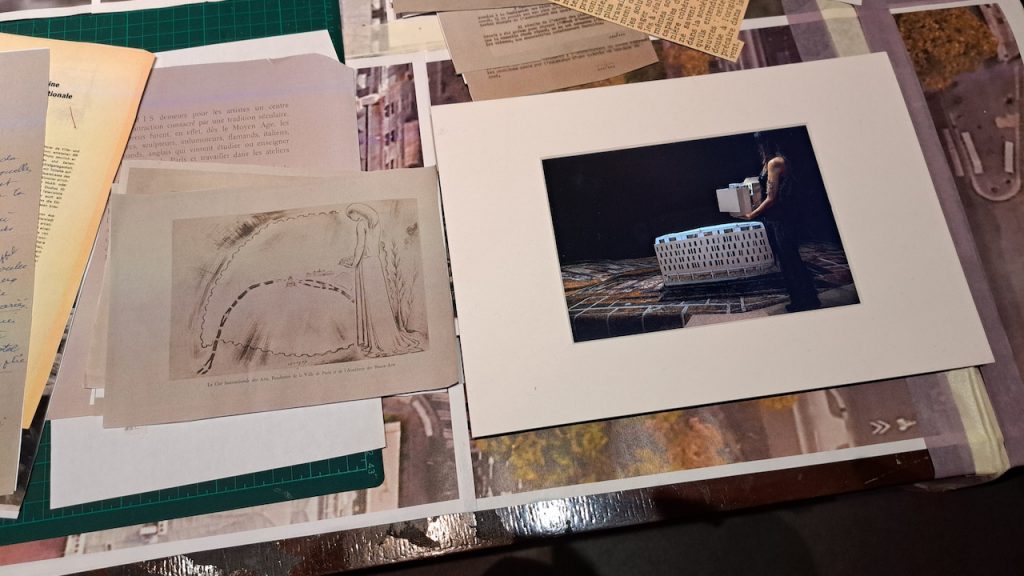Efrîn Özyetiş est une artiste et chercheuse basée à Paris (France). Docteure en architecture, elle a exercé diverses fonctions en tant que coordinatrice de projet, cheffe de projet et enseignante, tout en participant activement à des ateliers, conférences et publications académiques.
Sa pratique s’appuie sur des collaborations artistiques ainsi que sur l’expérimentation, avec des artefacts tangibles et visuels pour transformer les méthodologies de recherche en récits élaborés. Le travail d’Efrîn Özyetiş a été exposé à l’échelle internationale, notamment au musée Sabancı à Istanbul, aux Archives Onassis à Athènes, à l’ITA à Amsterdam, au Kunsthal Charlottenborg à Copenhague, et a récemment été présenté dans la sélection Venice Immersive en août 2025.
Ses recherches actuelles portent sur l’épistémologie du design, les écologies créatives, ainsi que sur les implications des technologies dans les notions philosophiques de vérité et de transmission du savoir.
Efrîn Özyetiş is an artist and researcher based in Paris, France.
Her practice is based on artistic collaborations and experimentation with tangible and visual artefacts to transform research methodologies into alternative narratives. Efrîn Özyetiş's work has been exhibited internationally, notably at the Sabancı Museum in Istanbul, the Onassis Archives in Athens, the ITA in Amsterdam, the Kunsthal Charlottenborg in Copenhagen, and was recently featured in the Venice Immersive selection in August 2025.
Her current research focuses on the epistemology of design, creative ecologies, and the implications of technology for philosophical notions of truth and knowledge transmission.

Dans cette installation du bureau de l’architecture, l’artiste réfléchit au paradoxe de vivre à Paris ; une ville qui affiche une hospitalité de façade tout en devenant de plus en plus hostile envers les étrangers. Bénéficiant d’une résidence sans porter les fardeaux du déplacement, l’artiste interroge ce que signifie chercher refuge dans un monde de plus en plus violent envers ceux et celles qu’il considère comme les “autres”.
S’inspirant d’une tradition philosophique française qui place l’éthique avant la politique et qui accorde une place centrale à la figure de l’étranger, l’artiste en explore les limites, notamment l’exclusion implicite de certains autres sous couvert d’universalité. Peut-il réellement exister une hospitalité inconditionnelle ? Et que faire lorsque cette tradition projette l’altérité dans des figures genrées : l’étranger comme femme, l’hôte comme hôtesse … risquant ainsi de renforcer les hiérarchies qu’elle prétend dépasser ?
Dans le cadre architectural brutaliste de la Cité internationale des arts, l’artiste reconfigure la Grande Galerie non plus comme un simple espace d’exposition, mais comme un lieu potentiel d’accueil. Observant les campements qui apparaissent chaque nuit devant la Cité internationale des arts, et s’appuyant sur des recherches archivistiques, l’artiste propose un autre usage de la Galerie : un programme architectural qui intègre le regard et la vulnérabilité de l’étranger comme paramètres de conception.
À la fois résidente et architecte fictive, l’artiste propose une intervention éthique et spatiale qui nous invite à repenser nos obligations envers l’étranger, à confronter les échecs de l’hospitalité philosophique, afin d’envisager le pouvoir transformateur d’un espace vu à travers les yeux de l’invité non sollicité.
In her installation An Alternative Plan for la Grande Galerie, Efrîn Özyetiş reflects on the paradox of living in Paris as someone afforded residence without bearing the burdens of displacement. In a context that performs hospitality while simultaneously becoming increasingly hostile to strangers, the artist interrogates what it means to seek refuge in a world that is growing ever more violent toward those it deems other.
Inspired by a French philosophical tradition that posits ethics as preceding politics, and which centers the figure of the stranger, the artist engages critically with its limitations, especially its tendency to exclude certain Others under the guise of universality. She is utilizing the performative aspect of architecture as a means to organize the space in response to problems that create the hostile environment one finds oneself in, while pretending there are no political, economic, or social factors that actually govern and dictate design, but that correct or favorable architectural solutions can address these hostilities rather than political ones.
Questioning whether hospitality can ever be truly unconditional, the work is
set within the brutalist architecture of the Cité internationale des arts, as the artist reimagines the Grand Gallery not as a neutral exhibition space, but as a site of potential shelter. By studying the nightly encampments outside the institution and drawing on archival research, the artist proposes an alternative architectural programme: one that centers the gaze and needs of the stranger as foundational to its design.
Acting as both inhabitant and architect, the artist introduces a counter-design, an ethical and spatial intervention that invites us to reconsider the obligations of hosting, the failures of philosophical hospitality, and the transformative power of viewing space through the eyes of the (un)invited guest.

Vous devez être connecté pour poster un commentaire.